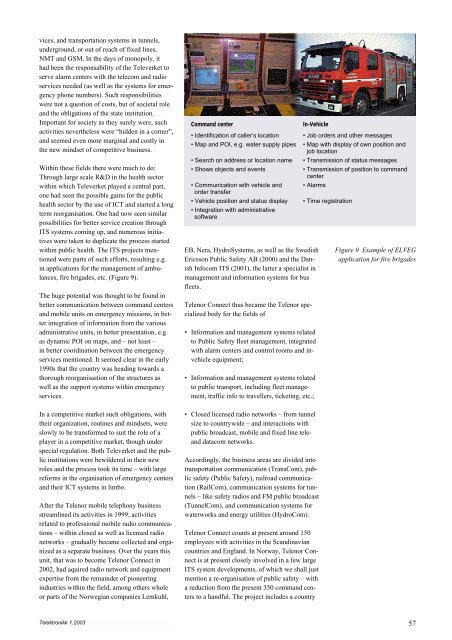Intelligent Transport Systems - Telenor
Intelligent Transport Systems - Telenor
Intelligent Transport Systems - Telenor
Create successful ePaper yourself
Turn your PDF publications into a flip-book with our unique Google optimized e-Paper software.
vices, and transportation systems in tunnels,<br />
underground, or out of reach of fixed lines,<br />
NMT and GSM. In the days of monopoly, it<br />
had been the responsability of the Televerket to<br />
serve alarm centers with the telecom and radio<br />
services needed (as well as the systems for emergency<br />
phone numbers). Such responsibilities<br />
were not a question of costs, but of societal role<br />
and the obligations of the state institution.<br />
Important for society as they surely were, such<br />
activities nevertheless were “hidden in a corner”,<br />
and seemed even more marginal and costly in<br />
the new mindset of competitive business.<br />
Within these fields there were much to do:<br />
Through large scale R&D in the health sector<br />
within which Televerket played a central part,<br />
one had seen the possible gains for the public<br />
health sector by the use of ICT and started a long<br />
term reorganisation. One had now seen similar<br />
possibilities for better service creation through<br />
ITS systems coming up, and numerous initiatives<br />
were taken to duplicate the process started<br />
within public health. The ITS projects mentioned<br />
were parts of such efforts, resulting e.g.<br />
in applications for the management of ambulances,<br />
fire brigades, etc. (Figure 9).<br />
The huge potential was thought to be found in<br />
better communication between command centers<br />
and mobile units on emergency missions, in better<br />
integration of information from the various<br />
administrative units, in better presentation, e.g.<br />
as dynamic POI on maps, and – not least –<br />
in better coordination between the emergency<br />
services mentioned. It seemed clear in the early<br />
1990s that the country was heading towards a<br />
thorough reorganisastion of the structures as<br />
well as the support systems within emergency<br />
services.<br />
In a competitive market such obligations, with<br />
their organization, routines and mindsets, were<br />
slowly to be transformed to suit the role of a<br />
player in a competitive market, though under<br />
special regulation. Both Televerket and the public<br />
institutions were bewildered in their new<br />
roles and the process took its time – with large<br />
reforms in the organisation of emergency centers<br />
and their ICT systems in limbo.<br />
After the <strong>Telenor</strong> mobile telephony business<br />
streamlined its activities in 1999, activities<br />
related to professional mobile radio communications<br />
– within closed as well as licensed radio<br />
networks – gradually became collected and organized<br />
as a separate business. Over the years this<br />
unit, that was to become <strong>Telenor</strong> Connect in<br />
2002, had aquired radio network and equipment<br />
expertise from the remainder of pioneering<br />
industries within the field, among others whole<br />
or parts of the Norwegian companies Lemkuhl,<br />
Telektronikk 1.2003<br />
Command center In-Vehicle<br />
• Identification of caller’s location • Job orders and other messages<br />
• Map and POI, e.g. water supply pipes • Map with display of own position and<br />
job location<br />
• Search on address or location name • Transmission of status messages<br />
• Shows objects and events • Transmission of position to command<br />
center<br />
• Communication with vehicle and • Alarms<br />
order transfer<br />
• Vehicle position and status display • Time registration<br />
• Integration with administrative<br />
software<br />
EB, Nera, Hydro<strong>Systems</strong>, as well as the Swedish<br />
Ericsson Public Safety AB (2000) and the Danish<br />
Infocom ITS (2001), the latter a specialist in<br />
management and information systems for bus<br />
fleets.<br />
<strong>Telenor</strong> Connect thus became the <strong>Telenor</strong> specialized<br />
body for the fields of<br />
• Information and management systems related<br />
to Public Safety fleet management, integrated<br />
with alarm centers and control rooms and invehicle<br />
equipment;<br />
• Information and management systems related<br />
to public transport, including fleet management,<br />
traffic info to travellers, ticketing, etc.;<br />
• Closed licensed radio networks – from tunnel<br />
size to countrywide – and interactions with<br />
public broadcast, mobile and fixed line teleand<br />
datacom networks.<br />
Accordingly, the business areas are divided into<br />
transportation communication (TransCom), public<br />
safety (Public Safety), railroad communication<br />
(RailCom), communication systems for tunnels<br />
– like safety radios and FM public broadcast<br />
(TunnelCom), and communication systems for<br />
waterworks and energy utilities (HydroCom).<br />
<strong>Telenor</strong> Connect counts at present around 150<br />
employees with activities in the Scandinavian<br />
countries and England. In Norway, <strong>Telenor</strong> Connect<br />
is at present closely involved in a few large<br />
ITS system developments, of which we shall just<br />
mention a re-organisation of public safety – with<br />
a reduction from the present 350 command centers<br />
to a handful. The project includes a country<br />
Figure 9 Example of ELVEG<br />
application for fire brigades<br />
57
















